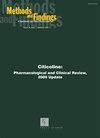Clinical and microbiological efficacy of prulifloxacin for the treatment of chronic bacterial prostatitis due to Chlamydia trachomatis infection: results from a prospective, randomized and open-label study.
Methods and findings in experimental and clinical pharmacology
Pub Date : 2010-01-01
DOI:10.1358/mf.2010.32.1.1423885
引用次数: 13
Abstract
The purpose of this study was to compare the efficacy of a 14-day course of prulifloxacin 600 mg with standard antibiotic therapy for the treatment of chronic prostatitis due to Chlamydia trachomatis (Ct) infection. All patients with clinical and instrumental diagnosis of bacterial chronic prostatitis (CP) due to Ct infection were enrolled. After randomization, all patients were administered oral prulifloxacin 600 mg once daily for 14 days or doxycycline 100 mg orally twice daily for 21 days. At enrollment and 30 days after beginning treatment, all patients underwent microbiological cultures for uropathogens bacteria and yeasts, DNA extraction and mucosal IgA evaluation for Ct diagnosis, seminal plasma IL-8 evaluation and serum IgA and IgG anti-Ct analysis. The National Institutes of Health - Chronic Prostatitis Symptom Index (NIH-CPSI) was given to each patient. A total of 109 patients received prulifloxacin and 102 received standard therapy. Prulifloxacin had clinical efficacy rates equivalent to standard therapy (82.5% vs. 79.9%) (P = 0.08) and showed superior microbiological efficacy rates compared to standard therapy, in terms of decreasing mucosal IgA (P < 0.001) and IL-8 levels (P < 0.001). Prulifloxacin was also equivalent to standard therapy for clinical success, as demonstrated by a decrease in the number of patients affected by CP due to Ct infection.普卢利沙星治疗沙眼衣原体感染引起的慢性细菌性前列腺炎的临床和微生物学疗效:一项前瞻性、随机和开放标签研究的结果
本研究的目的是比较普卢利沙星600毫克14天疗程与标准抗生素治疗沙眼衣原体(Ct)感染引起的慢性前列腺炎的疗效。所有临床和仪器诊断为Ct感染所致细菌性慢性前列腺炎(CP)的患者均入组。随机分组后,所有患者口服普卢利沙星600 mg,每日1次,连续14天或强力霉素100 mg,每日2次,连续21天。在入组时和开始治疗后30天,所有患者进行尿路病原菌和酵母菌微生物培养、DNA提取和粘膜IgA评估以进行Ct诊断、精浆IL-8评估和血清IgA和IgG抗Ct分析。每位患者均获得美国国立卫生研究院慢性前列腺炎症状指数(NIH-CPSI)。109例患者接受普卢利沙星治疗,102例患者接受标准治疗。普卢利沙星的临床有效率与标准治疗相当(82.5% vs. 79.9%) (P = 0.08),在降低黏膜IgA (P < 0.001)和IL-8水平(P < 0.001)方面,与标准治疗相比,在微生物学方面的有效率优于标准治疗。普卢利沙星也等同于临床成功的标准治疗,由于Ct感染而感染CP的患者数量减少。
本文章由计算机程序翻译,如有差异,请以英文原文为准。
求助全文
约1分钟内获得全文
求助全文
来源期刊
自引率
0.00%
发文量
0
审稿时长
>12 weeks

 求助内容:
求助内容: 应助结果提醒方式:
应助结果提醒方式:


